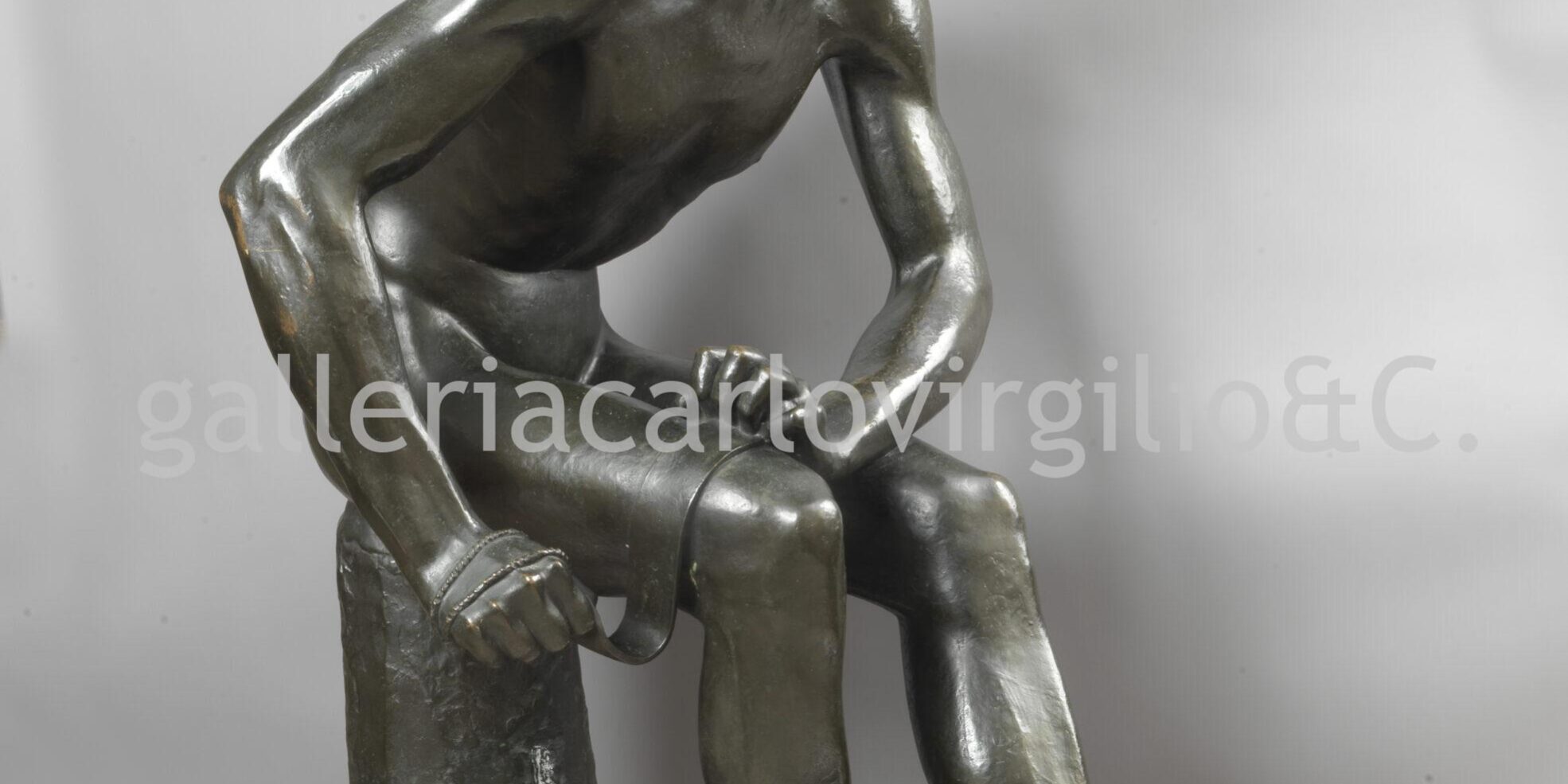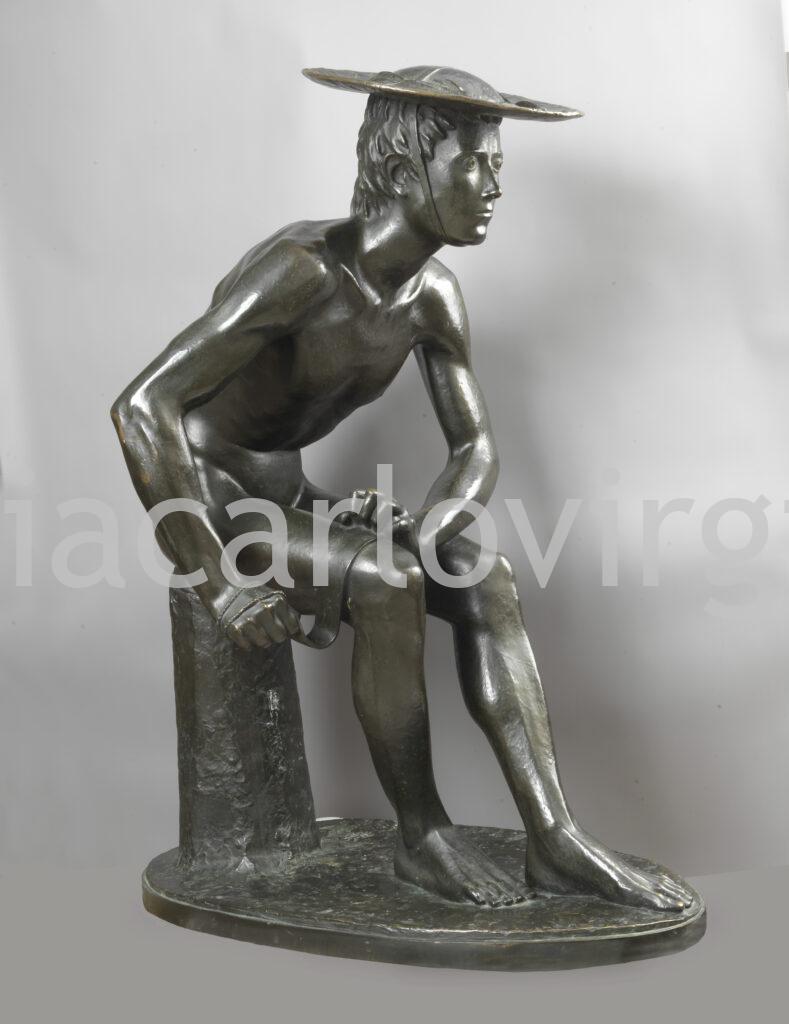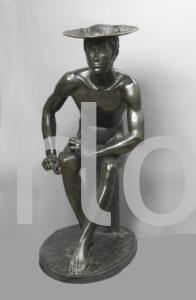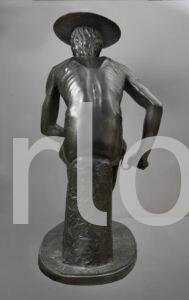| AVAILABLE

Venanzo Crocetti
Giulianova 1913 – Rome 2003
David • 1935
Bronze, 120 x 60 x 92 cm
Signed and dated on the side of the trunk: CROCETTI / 35
Essential Reference Bibliography:
XXI Biennale Internazionale d’Arte di Venezia 1938 – XVI, exhibition catalogue (Venezia, Palazzo dell’Esposizione, 1° giugno-30 settembre 1938), Venezia 1938, p. 116;
M. Venturoli, Crocetti, Roma 1972, p. 8, ill. 7
E. Carli, Crocetti, Roma 1979, p. 15
Scultura lingua morta / Dead Language Sculpture, exhibition catalogue (Leeds, Henry Moore Institute 31 maggio – 31 agosto; Museo di arte moderna e contemporanea di Trento e Rovereto 28 ottobre – 14 dicembre 2003), a cura di P. Curtis, 2003, ill. pp. 38, 108
Documents catalogued at nos. 19380615 | 19380910 | 19390609 in the Biblioteca Antonio Tancredi at Museo Crocetti, Rome
An artist with a long and prolific career, studded with recognition and commissions from all over the world – in particular, the victory in 1950 for one of the doors of St. Peter’s Basilica, the works for San Paolo del Brasile, solo exhibitions in Canada and Japan, the room dedicated to him at the Hermitage Museum, St. Petersburg, in 1991 – Venanzo Crocetti passed through the twentieth century with a language that places the figure – human or animal – at its centre.
Despite very humble origins, Crocetti’s precocious talent soon attracted attention and by 1932 he had won the National Sculpture Competition at the Accademia di San Luca in Rome. The following year he received an award at the Esposizione Nazionale di Firenze, a success that guaranteed him an invitation to participate in the Biennale di Venezia in 1934. Thus, when four years later, in 1938, at the XXI Biennale, with a selection of eight works, including this David, of decidedly personal iconography, he won the prize for sculpture, despite his young age, he could already be considered an established sculptor – the catalogue stating that ‘From 1930 he exhibited at all the national and international exhibitions.’
Crocetti’s early production is undoubtedly in the path of archaic reflection turned to taking up antiquity in an anti-heroic and anti-academic key, which developed in Italy from the twenties and within which the language of Arturo Martini (1889-1946) is the most representative expression – although, as the artist declared on several occasions, what interested him was more the horizon ‘where he looked,’ rather than the plastic achievement of the sculptor from Treviso. His ‘distant’ relationship with Martini is enriched then by an encounter in 1935 at the villa of the great patrons and collectors Ottolenghi Wedekind – who did not fail to buy works by Crocetti – and by a symbolic passing of the baton when in 1946, following the sudden death of the maestro from Treviso, for distinguished reputation, Crocetti succeeded him on the chair of sculpture at the Accademia di Belle Arti in Venice. In the cultural context of Crocetti’s training, the works of the other great figurative figures of the time shouldn’t be overlooked: Giacomo Manzù (1908-1991), Marino Marini (1901-1980) and Francesco Messina (1900-1995). However he moves away from them all for the strong architectonic sense of the firm structure of volumes on which his vigorous and terse modelling emerges, based on a heartfelt inspiration of what is popular, archaic and remote, with no lyrical accents, and yet animated by strong and intense spirituality.
In David, shown at the 1938 Biennale di Venezia, we find one of the most complete expressions of the robust plasticity of an archaic stamp in the early phase of Crocetti’s work. The sloping of plastic planes, simplified in an efficacious linearism, becomes sharper without losing naturalistic quality – notable in this sense, for example, is the emphasised relief that lets the bone structure of the back and tense muscles of the torso and arm emerge. Sealing the relationship with antiquity is the posture recalling Hermes at Rest from the Museo Archeologico Nazionale of Naples, and the presence of the wide, rigid brim, certainly inspired by the ancient Greece petasus, but that also suggests the one worn by Guerriero di Capestrano, a mysterious Italic sculpture dating back to the VI century BCE, found in 1934 in Abruzzo, the land of origin for which Crocetti held affection.
The David shown in Venice was bought by the Italian State for the then Regia Galleria degli Uffizi in Florence (today held in Palazzo Pitti) after a brief negotiation – as can be seen in the documents conserved at the Biblioteca Tancredi in Museo Crocetti, Rome.
The sculpture in question is another exemplar, autograph, on which origin Crocetti write as follows in a letter dated 5 October 1953 addressed to the painter Giulio Marchetti in Lucca: ‘An enthusiast insisted greatly on having a copy: and I indulged him, giving it a few re-touches, as far as I can remember.’
Eugenio Maria Costantini
For further information, to buy or sell works by Crocetti Venanzo (1913-2203) or to request free estimates and evaluations
mail info@carlovirgilio.co.uk
whatsapp +39 3382427650


